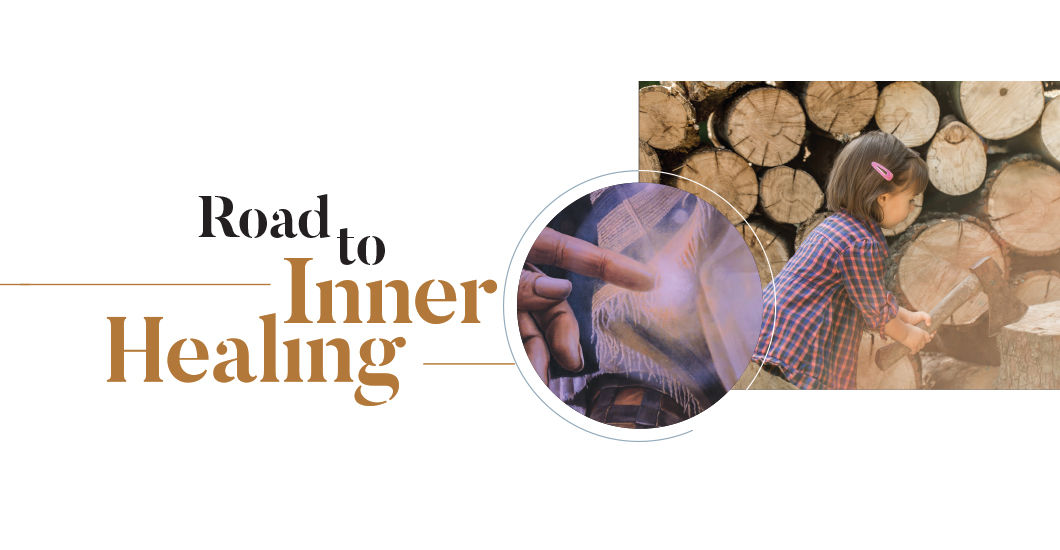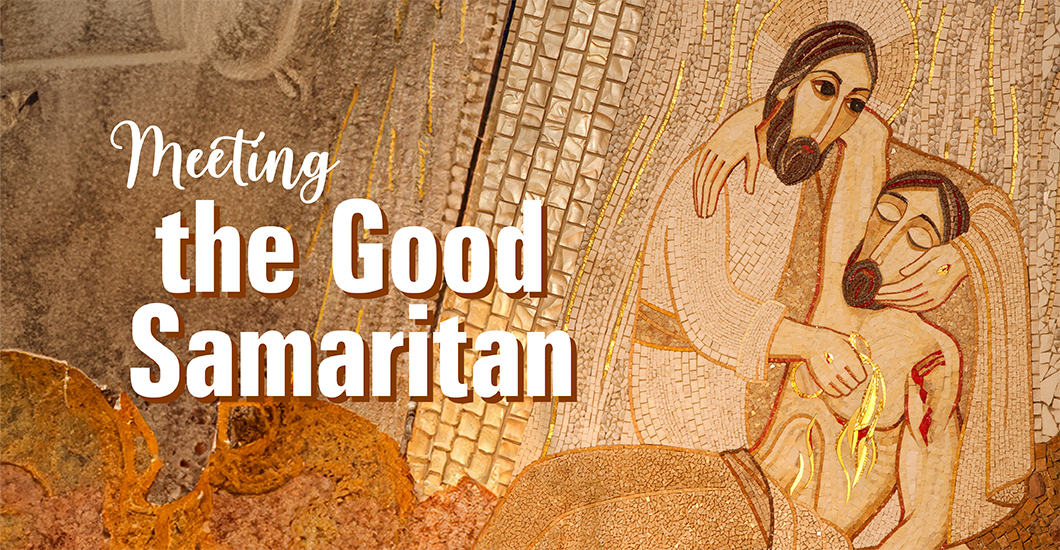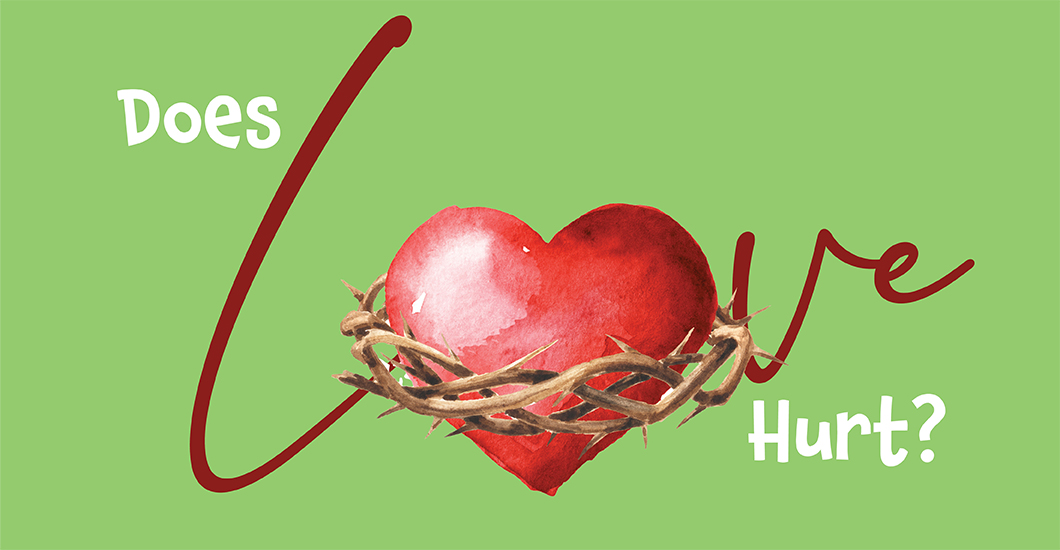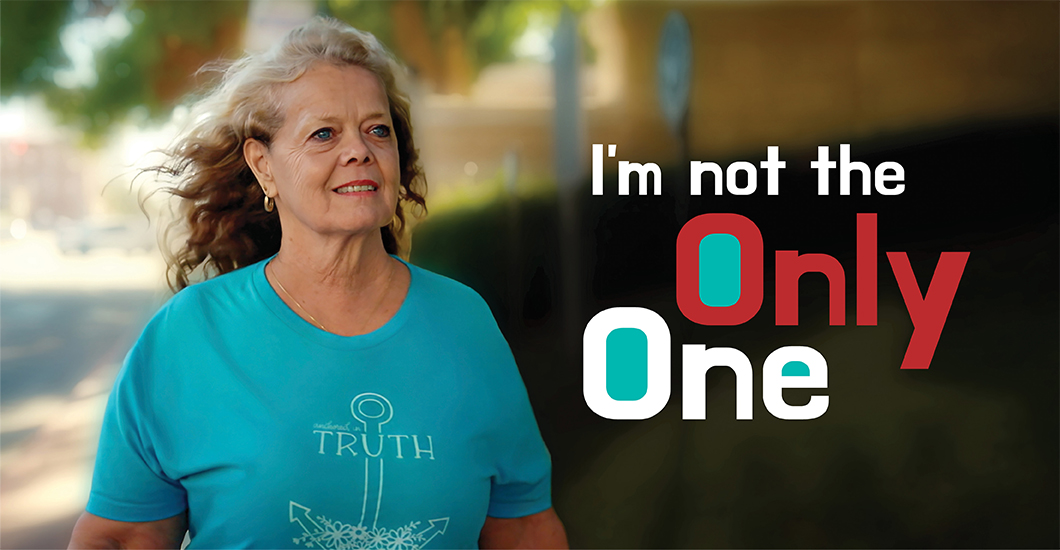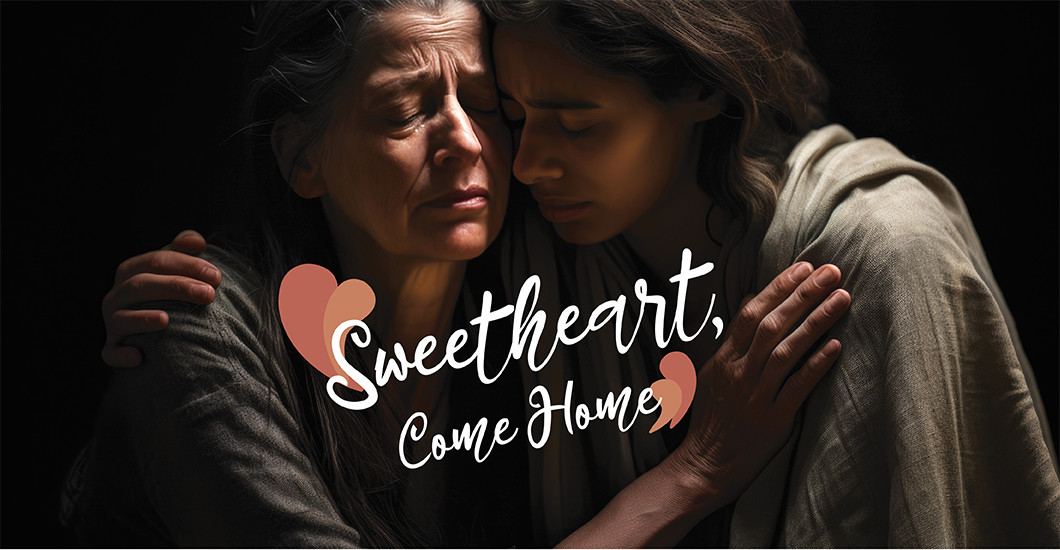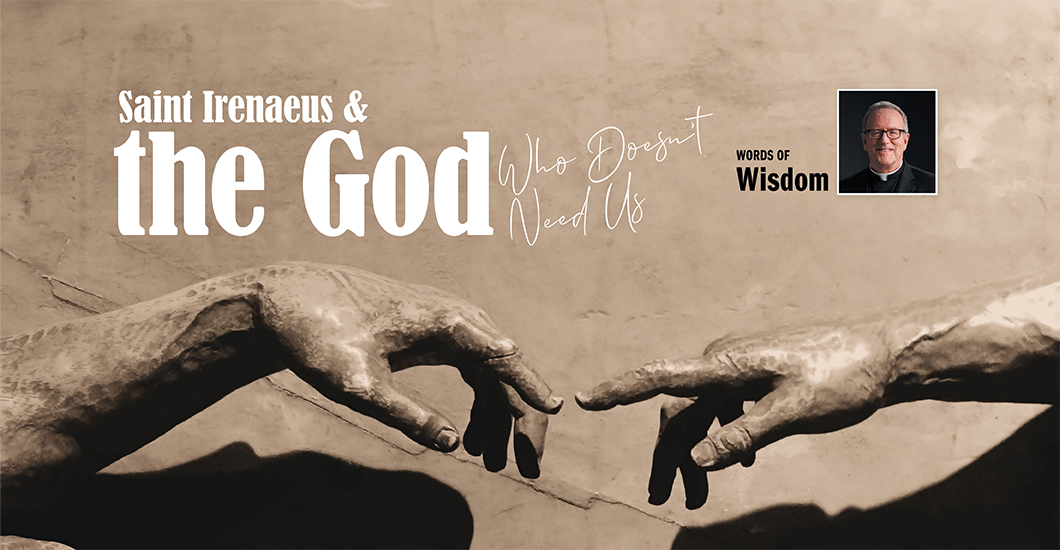Trending Articles
Road to Inner Healing
Seeking inner peace? Here are proven ways to heal your soul
The evening was cool; the church quiet, save for the soothing voice of a priest from the Prelature of Opus Dei. A dozen women reflected on his meditation. Despite the liturgical season of Easter, it was focused on the Cross.
“The Cross does not make victims,” declared the priest, as he indicated the crucifix hanging above the tabernacle. “It makes saints!”
He repeated that truth before continuing: “Faith in God does not mean that there will be no darkness in our lives. Faith is the light that guides our path through the darkness.”
It is easy for us to forget that The Cross can be a channel for inner healing. Too often we fall into the mindset of ‘carrying our crosses’ as a way of dismissing suffering without fully entering into its redemptive potential.
Playing the victim, and feeling sorry for ourselves does not aid the healing process. Instead, we are called to imitate Christ—the perfect victim.
A Lifelong Journey
“You have made us for Yourself, O Lord and our hearts are restless until they rest in You.” This famous line from Saint Augustine of Hippo never fails to resonate because we are made to know, love and serve God. To be fulfilled, we yearn for a meaningful life.
Although we deeply desire to know, love and serve God, we are still human: the spirit might be willing but the flesh is most certainly weak (cf. Matthew 26:41).
What began with the Original Sin of Adam and Eve, continues with the shadow of concupiscence—that part of our human nature that responds to the allure of sin. “The new life received in Christian initiation has not abolished the frailty and weakness of human nature, nor the inclination to sin that tradition calls concupiscence, which remains in the baptized such that with the help of the grace of Christ they may prove themselves in the struggle of Christian life.” (Catechism of the Catholic Church 1426)
In other words, even though the stain of Original Sin is washed from our souls through Baptism, we still find sin attractive. This attraction to sin will remain with us in this lifetime, but with the grace of Our Lord, we can grow in holiness.
Our willing submission to His will—the growing in His likeness—is the vocation of every soul. In practical terms, inner healing and our spiritual health are irrevocably intertwined. If we want to achieve true and lasting inner healing, then we need to advance in holiness, but it cannot be achieved overnight.
How Can I Touch Him?
In Matthew’s Gospel we read the following: And when they had crossed over, they came to land at Gennesaret. And when the men of that place recognized him, they sent round to all that region and brought to Him all that were sick, and besought Him that they might only touch the fringe of His garment; and as many as touched it were made well. (Matthew 14:34-36)
As many as touched it were made well—what a blessing for them. But what about us? We are not contemporaries of Jesus who can flock to Him and jostle with each other to touch the fringe of His tunic to gain inner healing.
However, the Catechism of the Catholic Church tells us: “In the sacraments Christ continues to ‘touch’ us in order to heal us.” (CCC 1504)
He comes to us in the sacraments! This is both a tremendous blessing and an ongoing source of hope. In particular the Sacraments of Confession and the Eucharist are a beautiful manifestation of God’s healing in action.
Through Confession: ‘The whole power of the Sacrament of Penance consists in restoring us to God’s grace and joining us with Him in an intimate friendship.’ Reconciliation with God is thus the purpose and effect of this sacrament. For those who receive the Sacrament of Penance with contrite heart and religious disposition, reconciliation ‘is usually followed by peace and serenity of conscience with strong spiritual consolation.’ Indeed the sacrament of Reconciliation with God brings about a true ‘spiritual resurrection’, restoration of the dignity and blessings of the life of the children of God, of which the most precious is friendship with God. (CCC 1468)
Frequent reception of the Eucharist is a supernatural phenomenon with benefits that are out of this world: “Holy Communion separates us from sin.” (CCC 1393) “As bodily nourishment restores lost strength, so the Eucharist strengthens our charity, which tends to be weakened in daily life; and this living charity wipes away venial sins.” (CCC 1394) “By the same charity that it enkindles in us, the Eucharist preserves us from future mortal sins. The more we share the life of Christ and progress in His friendship, the more difficult it is to break away from Him by mortal sin.” (CCC 1395)
Better Late Than Never
Zelie Martin, mother of Saint Therese of Lisieux, was canonised in 2015 alongside her husband Louis. This industrious mother and lace-maker knew all too well the effort and work required for inner healing.
She famously penned the following: I want to become a Saint; it will not be easy at all. I have a lot of wood to chop and it is as hard as stone. I should have started sooner, while it was not so difficult; but in any case ‘better late than never.’
Her own earthly journey to holiness would end with an early death, passing away from breast cancer when her youngest daughter Therese was just four years old. She knew the value of imitating the perfect victim; she carried her crosses, successfully ‘chopping the wood’ that was as hard as stone. The fruit of such work is easily visible in her family: religious vocations and canonizations.
Each of us has different ‘wood’ to chop. Our journeys to inner healing will vary, for though we are all created in His image and likeness, we are each of us unique and thus our strengths, weaknesses and personal experiences are different.
Regardless of this, the Catholic Church, the institution entrusted to Saint Peter, is a treasure trove of aids for inner healing and spiritual health. But we have to take the first step and reach out to Jesus, through the Church, and grasp firmly onto the hem of His tunic, resolving to continue to reach out should our grip loosen because we are distracted by our attraction to sin.
True inner healing can only come about if we have the faith to touch Jesus, to embrace both Him and His Cross; to trust in the redemptive suffering of The Cross in our own lives, to make frequent reception of the Sacraments a priority, and to look for our spiritual and emotional fulfillment in the eternal.
Pope Saint John Paul II was one of many who understood that true inner healing comes from God alone. Because of this, he spent much of his pontificate urging the faithful to cling to Christ, and to have the courage: “to be the Saints of the new millennium.”
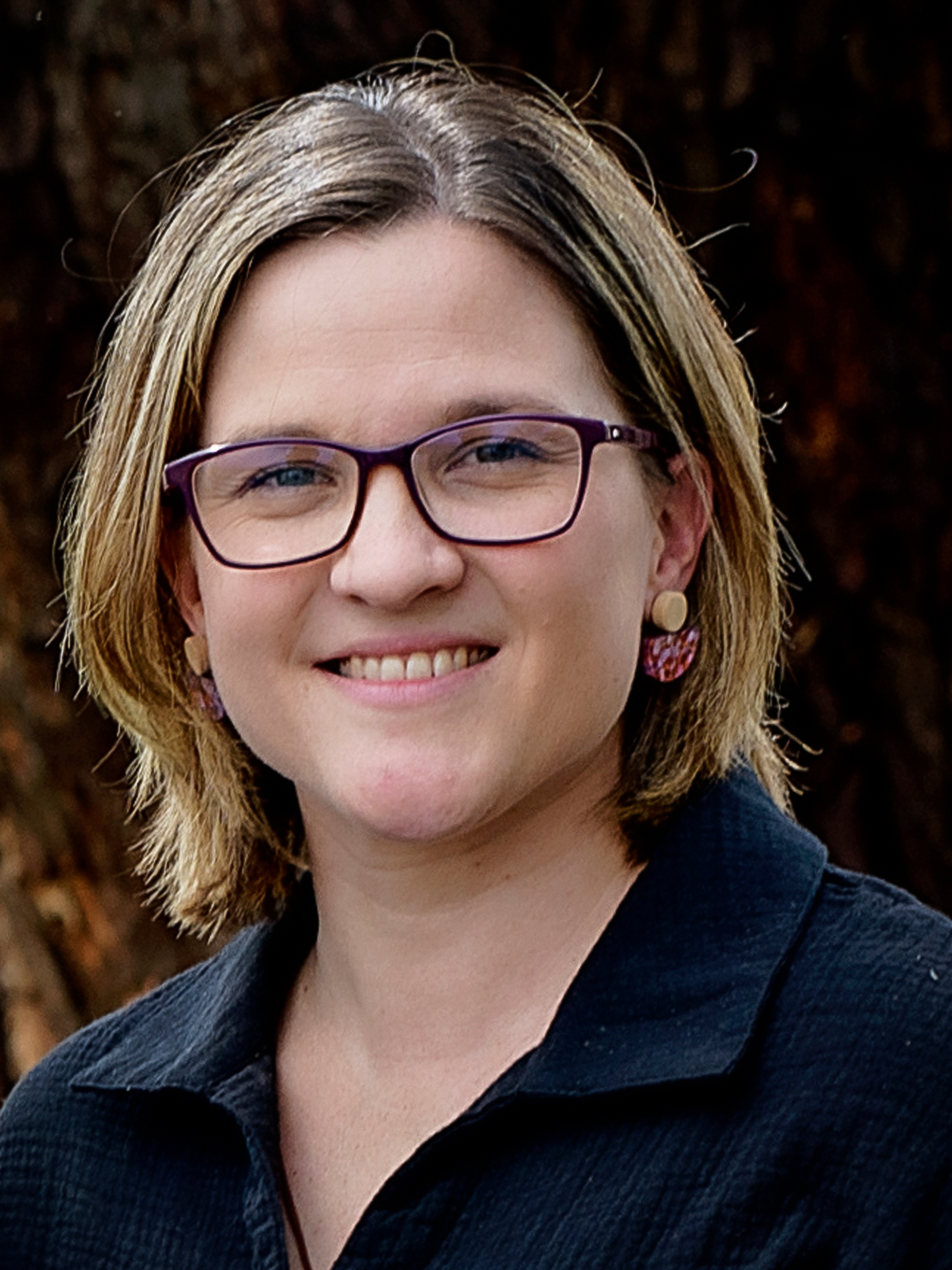
Emily Shaw is a former Australasian Catholic Press Association award-winning editor turned blogger for australiancatholicmums.com and is a contributor to Catholic-Link. A wife and mother of seven, she resides on a farm in rural Australia and enjoys the spiritual support of her local catholic community.
Related Articles
When a terrible loss led Josh Blakesley into the light, music from his soul became a balm to many bleeding hearts. Growing up in the small town of Alexandria, Josh was a carefree child. He grew up listening to his Dad’s music; two elder sisters with a great music collection was a bonus that nurtured his musical taste. Without professional training or theoretical inputs, in an age with no internet and YouTube, Josh had what he would later call ‘a side entry’ into the world of music. Starting on the drums and simultaneously learning to sing, he was enamored by the likes of Don Henley and Phil Collins, following their legendary works through magazines and books. With his mother, though, Church was a non-negotiable matter. Thanks to her insistence, he went to Mass every Sunday. But he would leave God there and live the rest of his life on a totally different plane. Diving Deeper They met in Spanish class when he was 15, and unlike any other 15-year-old, she took him along to a prayer meeting. This was new and different from anything he had experienced before. Teenagers his age were coming together to worship the Lord. This worship experience was modern and engaging…with music, talks, and skits by people his age! He was intrigued, but he wouldn’t have kept coming back every week if Jenny hadn’t asked him to. Several months later, Jenny was hit by a drunk driver and killed in an accident. Her loss was a huge blow to the entire community. As he struggled with the grief of losing her, it triggered a realization that life here is finite, and there must be purpose in it, a reason that we are living. From that very moment, he began a journey, searching for answers to the questions that fascinated him…‘What is the reason for me? What is the purpose of what I’m doing right now? Why has God put me on this planet? What’s my role while I’m here?’ He started diving more into why we were here on this planet. In realizing that his gifts were from God, and in searching for a purpose in the use of these gifts, he realized that he wanted to give back to God and return the love. A Bolt of Realization He started playing music for Mass and getting involved in the liturgy. As he puts it: “There has been a faith part to my music and a music part to my faith as well. Those are still ingrained. I pray through music a lot”. And it is this experience of prayer that he tries to hand over to his brethren through writing and playing music. The “awesome and overwhelming” experience of leading people into worship and hearing them singing along makes him whisper so often: “The Lord is moving right now, and I don’t have to work.” Bridging the Gap Josh is now a full-time singer, songwriter, producer, music director, husband, and dad. Even while leading the music at Mass every Sunday, Josh knows that Mass can happen without music—what a musician does at Mass doesn’t bring Jesus any greater into the room; He is there regardless. What a musician can do is “elevate the worship of the faithful by bringing some extra beauty through music.” This indeed, is one of his life goals—to try and bridge that gap and bring quality music into the liturgy. But he doesn’t stop there; in addition to adding beauty to the Sacramental experience, he goes another mile to bring God to the people. Right from His Heart As a Catholic musician, Josh writes songs for the Mass and writes from the heart. Sometimes, when it comes out, it might not be out rightly Mass-material, but what comes out is still a tribute to God for the gift of music. He relates that his song Even in This was such an experience right from his heart. The Church community he was part of had just lost a teen, and seeing them go through the pain, the tragedy, and the devastation took him back to his own experience of losing a dear friend in his teenage years. Diving into the pain, he wrote that even in these darkest nights, God is with us. In the ‘valleys of pain’, in the ‘shattered, broken things’, in the ' hurt you cannot hide’ and the ‘fear you cannot fight’, he reassures his listeners that though you cannot see God, “You are not alone.” This is one message Josh wants to repeat to the world: “God is moving with you.”
By: Josh Blakesley
MoreI remember a time in my ministry when I had felt a fellow minister distancing himself from me for no apparent reason. It seemed like he was struggling, but he wouldn’t share it with me. One Lenten day, burdened by this thought, I stood in my office and cried out to the Lord in my heart: “Jesus, I feel so left out of this person’s life.” Immediately, I heard Jesus respond with these sad words: “I know how you feel. It happens to Me every day.” Wow! I felt my own heart pierced, and tears flooded my eyes. I knew these words were a treasure. I continued for months to unpack that grace. Since my Baptism in the Holy Spirit twenty years ago, I had considered myself to have a deep personal relationship with Jesus. But this Word from my precious Savior and Lord opened a whole new insight into Jesus’ Heart. “Yes, Jesus, so many people forget You, don’t they? And me too—how often am I going about my tasks, forgetting to bring my problems and thoughts to You? All the while, You wait for me to turn back to You, who looks on me with such love.” In my prayer, I kept processing those words. “I know better now how You feel when someone rejects You, accuses or blames You, or does not talk to You for days or even years.” I would more consciously take my own sorrows to Jesus and tell Him: “Jesus, my Beloved, You feel this same sadness that I am feeling. I offer my little hurt to console You for so many people, including myself, who fail to console You.” I saw in a new way my favorite image, Jesus with His Sacred Heart’s rays of love flowing out, lamenting to Saint Margaret Mary: “Look at My Heart that loves people so much—but receives so little love in return.” Truly, Jesus gives me little trials daily so I can have a tiny taste of what He endured for us. I will always remember that moment of agony that brought me closer to the amazing, tender, long-suffering love of our dear Lord Jesus.
By: Sister Jane M. Abeln SMIC
MoreWould my life ever return to normal? How can I possibly continue my work? Brooding over these, a terrible solution popped into my head… I was finding life extremely stressful. In my fifth year at college, the onset of bipolar disorder was hindering my efforts to complete my teaching degree. I had no diagnosis yet, but I was plagued with insomnia, and I looked frazzled and unkempt, which impeded my prospects of employment as a teacher. Since I had strong natural tendencies toward perfectionism, I felt so ashamed and feared that I was letting everyone down. I spiraled into anger, despondency, and depression. People were concerned about my decline and tried to help. I was even sent to the hospital by ambulance from the school, but doctors could find nothing wrong except elevated blood pressure. I prayed but found no consolation. Even Easter Mass—my favorite time—didn’t break the vicious cycle. Why wouldn’t Jesus help me? I felt so angry with Him. Finally, I just stopped praying. As this continued, day after day, month after month, I didn’t know what to do. Would my life ever return to normal? It seemed unlikely. As graduation approached, my fear increased. Teaching is a tough job with few breaks, and the students would need me to remain level-headed while dealing with their many needs and providing a good learning environment. How could I possibly do this in my current state? A terrible solution popped into my head: “You should just kill yourself.” Instead of casting off that thought and sending it straight back to hell where it belonged, I let it sit. It seemed like a simple, logical answer to my dilemma. I just wanted to be numb instead of under constant attack. To my utter regret, I chose despair. But, in what I expected to be my last moments, I thought of my family and the type of person I had once been. In genuine remorse, I raised my head to the heavens and said: “I’m so sorry, Jesus. Sorry for everything. Just give me what I deserve.” I thought those would be the last words I would utter in this life. But God had other plans. Listening to the Divine My mother was, by providence, praying the Divine Mercy Chaplet at that very moment. Suddenly, she heard the words loud and clear in her heart “Go find Ellen.” She obediently set aside her rosary beads and found me on the floor of the garage. She caught on quickly, exclaiming in horror: “What are you doing?!” while she pulled me into the house. My parents were heartbroken. There’s no rulebook for times such as these, but they decided to take me to Mass. I was totally broken, and I needed a Savior more than ever before. I longed for a come-to-Jesus moment, but I was convinced that I was the last person in the world He would ever want to see. I wanted to believe that Jesus is my Shepherd and would come after His lost sheep, but it was hard because nothing had changed. I was still consumed by intense self-hatred, oppressed by darkness. It was almost physically painful. During the preparation of the gifts, I broke down in tears. I had not cried for a really long time, but once I started, I couldn’t stop. I was at the end of my own strength, with no idea where to go next. But as I wept, the weight slowly lifted, and I felt myself enfolded in His Divine Mercy. I didn’t deserve it, but He gave me the gift of Himself, and I knew that He loved me the same at my lowest point as much as He loved me at my highest point. In Pursuit of Love In the days to come, I could barely face God, but He kept showing up and pursuing me in the little things. I re-established communication with Jesus with the aid of a Divine Mercy picture in our living room. I tried to talk, mostly complaining about the struggle and then feeling bad about it in light of the recent rescue. Weirdly, I thought I could hear a tender voice whispering: “Did you really think I would leave you to die? I love you. I will never forsake you. I promise to never leave you. All is forgiven. Trust in my mercy.” I wanted to believe this, but I couldn’t trust that it was true. I was growing discouraged at the walls I was erecting, but I kept chatting with Jesus: “How do I learn to trust You?” The answer surprised me. Where do you go when you feel no hope but have to go on living? When you feel totally unlovable, too proud to accept anything yet desperately wanting to be humble? In other words, where do you want to go when you want a full reconciliation with the Father, Son, and Holy Spirit but are too scared and disbelieving of a loving reception to find your way home? The answer is the Blessed Virgin Mary, Mother of God, and Queen of Heaven. While I was learning to trust, my awkward attempts did not displease Jesus. He was calling me closer, closer to His Sacred Heart, through His Blessed Mother. I fell in love with Him and His faithfulness. I could admit everything to Mary. Although I feared that I could not keep my promise to my earthly mother because, on my own, I was still barely mustering the will to live, my mother inspired me to consecrate my life to Mary, trusting that she would help me get through this. I didn’t know much about what that meant, but 33 Days to Morning Glory and Consoling the Heart of Jesus by Father Michael E. Gaitley, MIC, helped me understand. The Blessed Mother is always willing to be our intercessor, and she will never turn down a request from a child wanting to return to Jesus. As I went through the consecration, I resolved never to attempt suicide again with the words: “No matter what happens, I will not quit.” Meanwhile, I started taking long walks on the beach while I talked with God the Father and meditated on the parable of the prodigal son. I tried to put myself in the shoes of the prodigal son, but it took me some time to get close to God the Father. First, I imagined Him at a distance, then walking toward me. Another day, I pictured Him running towards me even though it made Him look ridiculous to His friends and neighbors. Finally, the day came when I could picture myself in the arms of the Father, then being welcomed not just to His home but to my seat at the family table. As I envisaged Him pulling out a chair for me, I was no longer a headstrong young woman but a 10-year-old girl with ridiculous glasses and a bob haircut. When I accepted the Father’s love for me, I became like a little child again, living in the present moment and trusting Him completely. I fell in love with God and His faithfulness. My Good Shepherd has saved me from the prison of fear and anger, continuing to lead me along the safe path and carrying me when I falter. Now, I want to share my story so that everyone can know God’s goodness and love. His Sacred Heart is welling up with tender love and mercy just for you. He wants to love you lavishly, and I encourage you to welcome Him without fear. He will never abandon you or let you down. Step into His light and come home.
By: Ellen Wilson
MoreThrough the darkest valleys and toughest nights, Belinda heard a voice that kept calling her back. My mother walked out on us when I was around eleven. At the time, I thought that she left because she didn't want me. But in fact, after years of silently suffering through marital abuse, she couldn’t hold on anymore. As much as she wanted to save us, my father had threatened to kill her if she took us with her. It was too much to take in at such a young age, and as I was striving hard to navigate through this difficult time, my father started a cycle of abuse that would haunt me for years to come. Valleys and Hills To numb the pain of my father’s abuse and compensate for the loneliness of my mother’s abandonment, I started resorting to all kinds of ‘relief’ mechanisms. And at a point when I couldn’t stand the abuse anymore, I ran away with Charles, my boyfriend from school. I reconnected with my mother during this time and lived with her and her new husband for a while. At 17, I married Charles. His family had a history of incarceration, and he followed suit soon enough. I kept hanging out with the same bunch of people, and eventually, I, too, fell into crime. At 19, I got sentenced to prison for the first time—five years for aggravated assault. In prison, I felt more alone than I had ever been in my life. Everyone who was supposed to love and nurture me had abandoned me, used me, and abused me. I remember giving up, even trying to end my life. For a long time, I kept on spiraling downwards until I met Sharon and Joyce. They had given their lives to the Lord. Though I had no clue about Jesus, I thought I'd give it a try as I didn't have anything else. There, trapped inside those walls, I started a new life with Christ. Falling, Rising, Learning… About a year and a half into my sentence, I came up for parole. Somehow in my heart, I just knew I was going to make parole because I'd been living for Jesus. I felt like I was doing all the right things, so when the denial came back with a year set off, I just didn't understand. I started questioning God and was quite angry. It was at this time that I was transferred to another correctional facility. At the end of the church services, when the chaplain reached out for a handshake, I flinched and withdrew. He was a Spirit-filled man, and the Holy Spirit had shown him that I had been hurt. The next morning, he asked to see me. There in his office, as he asked about what had happened to me and how I was hurting, I opened up and shared for the first time in my life. Finally, out of prison and in private rehab, I started a job and was slowly getting a hold on my new life when I met Steven. I started going out with him, and we got pregnant. I remember being excited about it. As he wanted to make it right, we got married and started a family. That marked the beginning of probably the worst 17 years of my life, marked by his physical abuse and infidelity and the continuing influence of drugs and crime. He would even go on to hurt our kids, and this once sent me into a rage—I wanted to shoot him. At that moment, I heard these verses: “Vengeance is mine, I will repay.” (Romans 12:19) and “The Lord will fight for you” (Exodus 14:14), and that prompted me to let him go. Never a Criminal I was never able to be a criminal for long; God would just arrest me and try to get me back on track. In spite of His repeated efforts, I wasn't living for Him. I always kept God back, although I knew He was there. After a series of arrests and releases, I finally came home for good in 1996. I got back in touch with the Church and finally started building a true and sincere relationship with Jesus. The Church slowly became my life; I never really had that kind of a relationship with Jesus before. I just couldn't get enough of it because I started to see that it's not the things that I've done but who I am in Christ that's going to keep me on this road. But, the real conversion happened with Bridges to Life*. How can I Not? Even though I hadn’t been a participant in the program as an offender, being able to facilitate in those small groups was a blessing I hadn’t anticipated—one that would change my life in beautiful ways. When I heard other women and men share their stories, something clicked inside of me. It affirmed me that I was not the only one and encouraged me to show up time and again. I would be so tired and worn out from work, but I would walk into the prisons and just be rejuvenated because I knew that that was where I was supposed to be. Bridges to Life is about learning to forgive yourself; not only did helping others help me become whole, it also helped me heal…and I am still healing. First, it was my mother. She had cancer, and I brought her home; I looked after her for as long as she stayed until she passed away peacefully at my home. In 2005, my father’s cancer came back, and the doctors estimated he had at most six months. I brought him home too. Everybody told me not to take in this man after what he did to me. I asked: “how can I not?” Jesus forgave me, and I feel that God would want me to do this. Had I chosen to hold on to the bitterness or hatred toward my parents for the abandonment and the abuse, I don't know if they would have given their lives to the Lord. Just looking back over my life, I see how Jesus kept pursuing me and trying to help me. I was so resistant to feeling what was new, and it was so easy to stay in what was comfortable, but I am grateful to Jesus that I was able to finally completely surrender to Him. He is my Savior, He is my rock, and He is my friend. I just cannot imagine a life without Jesus.
By: Belinda Honey
MoreAre you quick to judge others? Are you hesitant to help someone in need? Then, it’s time to reflect! It was just another day for me. Returning from the market, weary from the day’s labor, collecting Roofus from the Synagogue school… However, something felt different that day. The wind was whispering in my ear, and even the sky was more expressive than usual. Commotion from a crowd in the streets confirmed for me that today, something was going to change. Then, I saw Him—His body so disfigured that I turned Roofus away from this fearful sight. The poor boy gripped my arm with all his might—he was terrified. The way this man, well, what was left of Him, was being handled must mean he had done something terrible. I could not bear to stand and watch, but as I began to leave, I was seized by a Roman soldier. To my horror, they commanded me to help this man to bear His heavy load. I knew this meant trouble. Despite resisting, they asked me to help Him. What a mess! I did not want to associate with a sinner. How humiliating! To carry a cross whilst all of them watched? I knew there was no escape, though, so I asked my neighbor Vanessa to take Roofus home because this trial would take a while. I walked over to Him—filthy, bloody, and disfigured. I wondered what he had done to deserve this. Whatever be it, this punishment was way too cruel. The bystanders were yelling out ‘blasphemer,’ ‘liar,’ and ‘King of the Jews,’ whilst others were spitting at him and abusing him. I had never been so humiliated and mentally tortured like this before. After taking only about ten to fifteen steps with him, he fell to the ground, face first. For this trial to end, he needed to get up, so I bent over to help him up. Then, in his eyes, I saw something that changed me. I saw compassion and love? How could this be? No fear, no anger, no hatred—just love and sympathy. I was taken aback, whilst with those eyes, He looked at me and held my hand to get back up. I could no longer hear or see the people around me. As I held the Cross on my one shoulder and Him on my other, I could only keep looking at Him. I saw the blood, the wounds, the spit, the dirt, everything that could no longer hide the divinity of His face. Now I heard only the beating of His heart and His labored breathing…He was struggling, yet so very, very strong. Amid all the noise of the people screaming, abusing, and scurrying about, I felt as though He was speaking to me. Everything else I had done till that point, good or bad, seemed pointless. When the Roman soldiers pulled Him from me to drag Him to the place of crucifixion, they shoved me aside, and I fell to the ground. He had to continue on His own. I lay there on the ground as people trampled over me. I did not know what to do next. All I knew was that Iife was never going to be the same again. I could no longer hear the crowd but only the silence and the sound of my heart beating. I was reminded of the sound of His tender heart. A few hours later, as I was about to get up to leave, the expressive sky from earlier began to speak. The ground beneath me shook! I looked ahead at the top of Calvary and saw Him, arms stretched and head bowed, for me. I know now that the blood splattered on my garment that day belonged to the Lamb of God, who takes away the sins of the world. He cleansed me with His blood. *** *** *** This is how I imagine Simon of Cyrene recalling his experience of the day he was asked to help Jesus carry the Cross to Calvary. He had probably heard very little of Jesus till that day, but I am very sure that he was not the same person after he helped the Savior carry that Cross. This Lenten season, Simon asks us to look into ourselves: Have we been too quick to judge people? Sometimes, we are too quick to believe what our instincts tell us about somebody. Just like Simon, we may let our judgments come in the way of helping others. Simon saw Jesus being scourged and assumed that He ought to have done something wrong. There might have been times when we let our presumptions about a person come in the way of loving them as Christ called us to. Are we hesitant to help some people? Shouldn’t we see Jesus in others and reach out to help them? Jesus asks us to love not only our friends but also strangers and enemies. Mother Teresa, being the perfect example of loving strangers, showed us how to see the face of Jesus in everyone. Who better to point at for an example of loving enemies than Jesus Christ Himself? He loved those who hated Him and prayed for those who persecuted Him. Like Simon, we may feel hesitant about reaching out to strangers or enemies, but Christ calls us to love our brothers and sisters just as He did. He died for their sins as much as He died for yours. Lord Jesus, thank You for giving us the example of Simon of Cyrene, who became a great witness for following Your Way. Heavenly Father, grant us the grace to become Your witnesses by reaching out to those in need.
By: Mishael Devassy
MoreJudging others is easy, but often enough, we go totally wrong in our judgment about others. I remember an old fellow who used to come to Saturday night Mass. He was much in need of a bath and clean clothes. Quite frankly, he stunk. You can't blame those who didn't want to be subject to this awful smell. He walked two or three miles every day around our little town, picking up trash, and lived in an old, run-down shack all by himself. It is easy for us to judge appearances. Isn't it? I suppose it is a natural part of being human. I don't know how many times my judgments about a person were totally wrong. In fact, it is quite difficult, if not impossible, to look beyond appearances without God's help. This man, for instance, despite his odd personality, was very faithful about participating in Mass every week. One day, I decided I would sit next to him at Mass regularly. Yes, he stunk, but he was also in need of love from others. By God's grace, the stink didn't bother me much. During the sign of peace, I would look him in the eye, smile, and greet him with a sincere: “Peace of Christ be with you.” Never Miss This When I entertain judgments about a person, I miss the opportunity that God wants to give me—an opportunity to see beyond the physical appearance and look into the person's heart. That is what Jesus did to each person He encountered on His journey, and He continues to look beyond our yuck and look at our hearts. I remember a time, being many years away from my Catholic faith, I sat in the Church parking lot, trying to muster enough courage to walk through the doors to attend Mass. I was so afraid that others would judge me and not welcome me back. I asked Jesus to walk in with me. Upon entering the Church, I was greeted by the Deacon, who gave me a big smile and a hug, and said: “Welcome.” That smile and hug were what I needed to feel like I belonged and was home again. Choosing to sit with the old man who stunk was my way of “paying it forward.” I knew how desperately I wanted to feel welcomed, to feel that I belonged and I mattered. Let us not hesitate to welcome each other, especially those who are difficult to be around.
By: Connie Beckman
MoreCaught in a spiral of drugs and sex work, I was losing myself, until this happened. It was night. I was in the brothel, dressed ready for “work.” There was a gentle knock at the door, not the big bang by the police, but a truly gentle tap. The brothel lady—the Madame—opened the door, and my mother walked in. I felt ashamed. I was dressed for this “work” that I had been doing for months now, and there in the room was my mom! She just sat there and told me: “Sweetheart, please come home.” She showed me love. She didn't judge me. She just asked me to come back. I was overwhelmed by grace at that moment. I should have gone home then, but the drugs would not let me. I sincerely felt ashamed. She wrote her phone number down on a piece of paper, slid it across, and told me: “I love you. You can call me anytime, and I'll come.” The next morning, I told a friend of mine that I wanted to get off heroin. I was scared. At 24, I was tired of life, and it felt like I'd lived enough to be done with life. . My friend knew a doctor who treated drug addicts, and I got an appointment in three days. I called my mom, told her I was going to the doctor, and that I wanted to get off heroin. She was crying on the phone. She jumped in the car and came straight to me. She'd been waiting… How it all began Our family shifted to Brisbane when my father got a job at Expo 88. I was 12. I was enrolled at an elite private girls’ school, but I just didn’t fit in. I dreamed of going to Hollywood and making movies, so I needed to attend a school that specializes in Film and TV. I found a school renowned for Film and TV, and my parents easily gave in to my request to change schools. What I didn't tell them was that the school was also in the newspapers because they were infamous for gangs and drugs. The school gave me so many creative friends, and I excelled in school. I topped a lot of my classes and won awards for Film, TV, and Drama. I had the grades to get to University. Two weeks before the end of grade 12, someone offered me marijuana. I said yes. At the end of school, we all went away, and again I tried other drugs... From the kid who was laser-focused on finishing school, I went on a downward spiral. I still got into University, but in the second year, I ended up in a relationship with a guy who was a heroin addict. I remember all of my friends at the time telling me: “You're going to end up a junkie, a heroin addict.” I, on the other hand, thought I was going to be his savior. But all the sex, drugs, and rock and roll ended up getting me pregnant. We went to the doctor, my partner still high on heroin. The doctor looked at us and immediately advised me to get a termination—she must have felt that with us, this child had no hope. Three days later, I had an abortion. I felt guilty, ashamed, and alone. I would watch my partner take heroin, get numb, and be unaffected. I begged him for some heroin, but he was all: “I love you, I'm not giving you heroin.” One day, he needed money, and I managed to bargain some heroin in return. It was a tiny bit, and it made me sick, but it also made me feel nothing. I kept on using, the dose getting higher and higher each time. I eventually dropped out of University and became a frequent user. I had no idea how I was going to pay for almost a hundred dollars’ worth of heroin I was using on a daily basis. We started growing marijuana in the house; we would sell it and use the money to buy even more drugs. We sold everything we owned, got kicked out of my apartment, and then, slowly, I started stealing from my family and friends. I didn't even feel ashamed. Soon, I started stealing from work. I thought they didn’t know, but I eventually got kicked out of there too. Finally, the only thing that I had left was my body. That first night I had sex with strangers, I wanted to scrub myself clean. But I couldn't! You can't scrub yourself clean to the inside out...But that didn’t stop me from going back. From making $300 a night and spending all of it on heroin for my partner and me, I went to make a thousand dollars a night; every cent I made went into buying more drugs. It was in the middle of this downward spiral that my mother walked in and saved me with her love and mercy. But that wasn’t enough. A Hole in My Soul The doctor asked me about my drug history. As I went over the long story, my mum kept on crying—she was shocked by the fullness of my story. The doctor told me that I needed rehab. I asked: “Don't drug addicts go to rehab?” He was surprised: “You don't think you are one?” Then, he looked me in the eye and said: “I don't think drugs are your problem. Your problem is, you have a hole in your soul that only Jesus can fill.” I purposefully chose a rehab that I was sure to be non-Christian. I was sick, starting to slowly detox when, one day after dinner, they called us all out for a prayer meeting. I was angry, so I sat in the corner and tried to block them out—their music, their singing, and their Jesus everything. On Sunday, they took us to church. I stood outside and smoked cigarettes. I was angry, hurt, and lonely. Begin Anew On the sixth Sunday, August 15, it was pouring rain—a conspiracy from Heaven, in hindsight. I had no choice but to go inside the building. I stayed at the back, thinking that God couldn't see me there. I had started to become aware that some of my life choices would be considered sins, so there I sat, at the back. At the end however, the priest said: “Is there anyone in here who would like to give their heart to Jesus today?” I remember standing in front and listening to the priest say: “Do you want to give your heart to Jesus? He can give you forgiveness for your past, a brand new life today, and hope for your future.” By that stage, I was clean, off heroin for almost six weeks. But what I didn't realize was that there was much difference between being clean and being free. I repeated the Salvation prayer with the priest, a prayer I didn’t even understand, but there, I gave my heart to Jesus. That day, I began a transformation journey. I got to begin anew, receive the fullness of the love, grace, and goodness of a God who had known me my whole life and saved me from myself. The way forward was not one without mistakes. I got into a relationship in rehab, and I got pregnant again. But instead of thinking of it as a punishment for a bad choice that I had made, we decided to settle down. My partner said to me: “Let's get married and do our best to do it His way now.” Grace was born a year later, through her, I have experienced so much grace. I've always had the passion to tell stories; God gave me a story that has helped to transform lives. He has since used me in so many ways to share my story—in words, in writing, and in giving my all to work for and with the women who are stuck in a similar life that I used to lead. Today, I am a woman changed by grace. I was met by the love of Heaven, and now I want to live life in a way that allows me to partner with the purposes of Heaven.
By: Bronwen Healy
MoreAs an only child, I had this 'baby fantasy'. Every time a cousin was born, I prepared with great ado, trimming my nails and washing up well so I could touch the baby. Waiting for Christmas felt the same as I was preparing to receive baby Jesus into my heart. Once in college, during the Christmas Mass, a thought struck me: this adorable baby Jesus is soon going to mount up to Calvary and be crucified, for Lent was just a few months away. I was perturbed, but later, God gave me the conviction that life is never without the cross. Jesus suffered so He could be with us in our sufferings. I did not fully grasp the sublime meaning of suffering until my little Anna was born premature at 27 weeks of pregnancy and all the complications that followed—severe brain damage, epileptic seizures, and microcephaly. Sleepless nights and constant cries, there wasn't an easy day from then on. I had a plethora of dreams and aspirations, but with my little one needing me so much, I had to forgo all of it. One day, I was brooding over how my life had become home-bound with Anna, now about 7 years old, stretching across my lap and slowly gulping some water little by little. In my mind, there was a lot of noise, but I could distinctly hear angelic music, and the words were repeated, over and over again: “Jesus…Jesus...this is Jesus.” With her long arms and legs, and her slender body sprawling over my lap, it suddenly dawned on me—there was a striking resemblance with the Pieta, recalling how at the foot of the Cross, Jesus lay silently on His mother's lap. Tears flowed and I was brought to the reality of God's presence in my life. When pinned down with the cares and worries of life, I sometimes gasp for even the most menial tasks, but then I remember I am not alone. Every child God gives us is truly a blessing. While Anna depicts the suffering Jesus, our 5-year-old son wipes the drool from Anna's face and promptly gives her medicine. He reminds me of the child Jesus helping his father and mother with the daily chores. Our little 3-year-old daughter never tires of thanking Jesus for even the most trivial things, bringing to mind how the child Jesus grew in wisdom and love. Our one-year-old cherub, with his little cheeks, plump rounded hands and legs, resembles the sculpted baby Jesus, bringing to mind how Mama Mary nurtured and cared for the little one. As he smiles and turns in his sleep, there’s even a glimpse of baby Jesus gently sleeping. If Jesus hadn’t come down to be amongst us, would I still have the peace and joy I experience every day? If I hadn’t known His love, would I experience the beauty of seeing Jesus in my children and doing everything for them as I would for Him?
By: Reshma Thomas
MoreShe was diagnosed with chronic OCD, and put on meds for a lifetime. Then, something unexpected happened. In the 1990s, I was diagnosed with Obsessive Compulsive Disorder. The doctor prescribed me medication and told me I would have to take them for the rest of my life. Some people think that mental health issues happen because you lack faith, but there was nothing wrong with my faith. I had always deeply loved God and relied on Him in all things, but I also felt an abiding disabling guilt. I had not been able to shake off the belief that everything that was wrong with the world was my fault. I had a Law degree, but my heart had never been there. I had taken up law to impress my mother, who thought my choice of teaching as a profession wasn’t good enough. But I had married and given birth to my first child just before I finished it, then gone on to have seven beautiful children, so I had spent more time learning to be a mother than working in law. When we moved to Australia, the law was different, so, I went back to university to finally study my first love, Teaching. But even when I got a job doing what I loved, I felt that I was trying to justify my existence by earning money. Somehow, I didn’t feel that looking after my family and nurturing the people entrusted to me was good enough. In fact, with my crippling guilt and feeling of inadequacy, nothing ever felt enough. Totally Unexpected Because of our family size, it wasn’t always easy to get away on a holiday, so we were excited when we heard about the Carry Home in Pemberton where payment was a donation of what you could afford. It had a beautiful country setting close to forests. We planned to go for a weekend family retreat. They also had a prayer and worship group in Perth. When I joined, I was made to feel very welcome. There, at one of the retreats, something totally unexpected and overwhelming happened. I had just received prayer when I suddenly fell to the ground. Rolled up on the floor in a fetal position, I screamed and screamed and screamed. They carried me out onto this rickety old wooden verandah outside and continued to pray until eventually, I stopped screaming. This was totally unsought and unexpected. But I knew that it was deliverance. I just felt empty as if something had left me. After the retreat, my friends continued to check up on me and come to pray over me, asking for Mary’s intercession that the gifts of the Holy Spirit would become manifest in me. I felt so much better that after a week or two, I decided to reduce my dose of medication. Within three months, I had stopped taking the medication and felt better than I ever had. Melting Away I no longer felt the need to prove myself or pretend that I was better than I was. I didn’t feel that I had to excel in all things. I felt grateful for the gift of life, my family, my prayerful community and this tremendous connection with God. Freed of the need to justify my existence, I realized I could not justify my existence. It’s a gift–life, family, prayer, connection with God–these are all gifts, not something you are ever going to earn. You accept it and you thank God. I became a better person. I didn’t have to show off, compete, or arrogantly insist that my way was the best. I realized I didn’t have to be better than the other person because it didn’t matter. God loves me, God cares for me. Out of the grip of my disabling guilt, I have since realized that “If God didn’t want me, He would have made someone else.” My relationship with my mother had always been ambivalent. Even after becoming a mother, I was still struggling with these feelings of ambivalence. But this experience changed that for me. As God chose Mary to bring Jesus into the world, He had chosen Mary to help me on my way. My issues in the relationship with my mother, and subsequently with the Holy Mother, slowly melted away. I felt like John at the foot of the Cross when Jesus told him: “Behold your Mother.” I have come to know Mary as the perfect mother. Now, when my mind fails, the Rosary kicks in to rescue me! I never realized how much I needed her until I made her an indispensable part of my life. Now, I couldn’t imagine stepping away.
By: Susen Regnard
MoreWhen thoughts of worthlessness creep in, try this… He reeked. His filthy, starving body wasted away like his squandered inheritance. Shame engulfed him. He had lost everything—his wealth, his reputation, his family—his life was broken. Despair consumed him. Then, suddenly, his father’s gentle face flashed across his mind. Reconciliation seemed impossible, but in his desperation, he “set off and went to his father. But while he was still far off, his father saw him and was filled with compassion; he ran and put his arms around him and kissed him. Then the son said to him: ‘Father, I have sinned against Heaven and before you; I am no longer worthy to be called your son.’...But the father said…‘this son of mine was dead and is alive again; he was lost and is found!’ And they began to celebrate” (Luke 15:20-24). Accepting God’s forgiveness is hard. Admitting our sins means admitting we need our Father. And as you and I wrestle with guilt and shame from past offenses, Satan the accuser assaults us with his lies: “You are unworthy of love and forgiveness.” But the Lord calls us to reject this lie! At baptism, your identity as a child of God was stamped on your soul forever. And just like the prodigal son, you are called to discover your true identity and worthiness. God never stops loving you, no matter what you have done. “I will not reject anyone who comes to me” (John 6:37). You and I are no exceptions! So, how can we take practical steps to accept God’s forgiveness? Seek the Lord, embrace His mercy, and be restored by His powerful grace. Seek the Lord Find your nearest church or adoration chapel and meet the Lord face to face. Ask God to help you see yourself through His merciful eyes with His unconditional Love. Next, make an honest and courageous inventory of your soul. Be brave and look at Christ on the Crucifix as you reflect—bring yourself to the Lord. Admitting the reality of our sins is painful, but an authentic, vulnerable heart is ready to receive the fruits of forgiveness. Remember, you are a child of God—the Lord will not turn you away! Embrace God’s Mercy Wrestling with guilt and shame can be like trying to hold a beach ball under the surface of water. It takes so much effort! On top of this, the devil often leads us to believe we are unworthy of God’s love and forgiveness. But from the Cross, Christ’s blood and water flowed from His side to cleanse, heal, and save us. You and I are called to radically trust in this Divine Mercy. Try saying: “I am a child of God. Jesus loves me. I am worthy of forgiveness.” Repeat this truth every day. Write it somewhere you see often. Ask the Lord to help you release yourself into His tender embrace of mercy. Let go of the beach ball and surrender it to Jesus—nothing is impossible for God! Be Restored In the Sacrament of Confession, we are restored by God’s graces of healing and strength. Fight against the devil’s lies and meet Christ in this powerful Sacrament. Tell the priest if you struggle with guilt or shame, and when you say your act of contrition, invite the Holy Spirit to inspire your heart. Choose to believe in God’s infinite mercy as you hear the words of absolution: “May God give you pardon and peace, and I absolve you of your sins in the name of the Father, and of the Son, and of the Holy Spirit.” You are now restored in the unconditional love and forgiveness of God! Despite my failures, I ask God every day to help me accept His love and forgiveness. We may have fallen like the prodigal son, but you and I are still God’s sons and daughters, worthy of His endless love and compassion. God loves you, right here, right now—He gave up His life for you because of love. This is the transforming Hope of the Good News! So, embrace God’s forgiveness and dare to courageously accept His Divine Mercy. God’s inexhaustible compassion awaits you! “Fear not, for I have redeemed you; I have called you by name, you are mine” (Isaiah 43:1).
By: Jody Weis
MoreLatest Articles
Several years ago, I participated in the annual meeting of the Academy of Catholic Theology, a group of about fifty theologians dedicated to thinking according to the mind of the Church. Our general topic was the Trinity, and I had been invited to give one of the papers. I chose to focus on the work of Saint Irenaeus, one of the earliest and most important of the fathers of the Church. Irenaeus was born around 125 in the town of Smyrna in Asia Minor. As a young man, he became a disciple of Polycarp who, in turn, had been a student of John the Evangelist. Later in life, Irenaeus journeyed to Rome and eventually to Lyons where he became Bishop after the martyrdom of the previous leader. Irenaeus died around the year 200, most likely as a martyr, though the exact details of his death are lost to history. His theological masterpiece is called Adversus Haereses (Against the Heresies), but it is much more than a refutation of the major objections to Christian faith in his time. It is one of the most impressive expressions of Christian doctrine in the history of the church, easily ranking with the De Trinitate of Saint Augustine and the Summa theologiae of Saint Thomas Aquinas. In my Washington paper, I argued that the master idea in Irenaeus’s theology is that God has no need of anything outside of Himself. I realize that this seems, at first blush, rather discouraging, but if we follow Irenaeus’s lead, we see how, spiritually speaking, it opens up a whole new world. Irenaeus knew all about the pagan gods and goddesses who stood in desperate need of human praise and sacrifice, and he saw that a chief consequence of this theology is that people lived in fear. Since the gods needed us, they were wont to manipulate us to satisfy their desires, and if they were not sufficiently honored, they could (and would) lash out. But the God of the Bible, who is utterly perfect in Himself, has no need of anything at all. Even in His great act of making the universe, He doesn’t require any pre-existing material with which to work; rather (and Irenaeus was the first major Christian theologian to see this), He creates the universe ex nihilo (from nothing). And precisely because He doesn’t need the world, He makes the world in a sheerly generous act of love. Love, as I never tire of repeating, is not primarily a feeling or a sentiment, but instead an act of the will. It is to will the good of the other as other. Well, the God who has no self-interest at all, can only love. From this intuition, the whole theology of Irenaeus flows. God creates the cosmos in an explosion of generosity, giving rise to myriad plants, animals, planets, stars, angels, and human beings, all designed to reflect some aspect of His own splendor. Irenaeus loves to ring the changes on the metaphor of God as artist. Each element of creation is like a color applied to the canvas or a stone in the mosaic, or a note in an overarching harmony. If we can’t appreciate the consonance of the many features of God’s universe, it is only because our minds are too small to take in the Master’s design. And His entire purpose in creating this symphonic order is to allow other realities to participate in His perfection. At the summit of God’s physical creation stands the human being, loved into existence as all things are, but invited to participate even more fully in God’s perfection by loving his Creator in return. The most oft-cited quote from Irenaeus is from the fourth book of the Adversus Haereses, and it runs as follows: “The glory of God is a human being fully alive.” Do you see how this is precisely correlative to the assertion that God needs nothing? The glory of the pagan gods and goddesses was not a human being fully alive, but rather a human being in submission, a human being doing what he’s been commanded to do. But the true God doesn’t play such manipulative games. He finds His joy in willing, in the fullest measure, our good. One of the most beautiful and intriguing of Irenaeus’ ideas is that God functions as a sort of benevolent teacher, gradually educating the human race in the ways of love. He imagined Adam and Eve, not so much as adults endowed with every spiritual and intellectual perfection, but more as children or teenagers, inevitably awkward in their expression of freedom. The long history of salvation is, therefore, God’s patient attempt to train His human creatures to be His friends. All of the covenants, laws, commandments, and rituals of both ancient Israel and the church should be seen in this light: not arbitrary impositions, but the structure that the Father God gives to order His children toward full flourishing. There is much that we can learn from this ancient master of the Christian faith, especially concerning the good news of the God who doesn’t need us!
By: Bishop Robert Barron
MoreQ – How do I know if my love for sports is idolatry? I practice four hours a day, hoping to get a college scholarship, and I think about it all the time, following the professional teams closely. I love God, but He just doesn’t hold my interest like sports do. When does my passion cross the line into idolatry? A – I, too, am passionate about sports. I played baseball in high school and college, and even as a priest, I continue to play Ultimate Frisbee, soccer, and American football. Sports can be “the field of virtue,” as Saint John Paul II once said. But in our modern world, we do often hold sports in very high esteem…perhaps too high. My college baseball coach had a great saying: “Nothing in sports is eternal.” That helped me keep everything in perspective. Winning the championship or losing the game won’t make a bit of difference in eternity. It is meant to be fun, giving us a chance to exercise and practice teamwork, discipline, courage, and fairness—but there are no eternal consequences to an athletic contest. So how do we keep sports in its proper perspective? We look at three things to know if sports (or anything else) has become an idol: First, time. How much time do we spend on it versus how much time do we spend with the Lord? I once challenged a class of teens to spend ten minutes per day in prayer, and one boy told me that was impossible because he played video games. I asked him how much he played, and he told me that he often played eight to eleven hours per day! If a person doesn’t have time for a serious prayer life—fifteen to twenty minutes minimum, every day, because they are spending that time on sports, then it is indeed idolatry. This doesn’t mean that it has to be perfectly equal—if you practice for two hours per day, you don’t necessarily need to pray for two hours per day. But there does need to be enough time in your life to have a solid prayer life. This includes making sure that our sports life does not conflict with Sunday worship. My brother, an excellent ballplayer, once had to miss an important tryout because it was being held on Easter Sunday morning. Whatever we do instead of Sunday Mass becomes our idol! This also includes making time an integral part of our sacrifice for the Lord. Do you have the time to volunteer at your church or a local charity? Do you have enough time to perform your daily duties well (to do your studies to the best of your ability, to do household chores, and to be a good son/daughter and friend)? If sports take up so much time that there is no time to give back to others, then we are out-of-balance. Second, money. How much money do we spend on sports games, equipment, trainers, gym memberships—versus how much money do we give to the church, charities, or the poor? Where we spend our money determines what our priorities are. Again, this isn’t necessarily a perfectly equal ratio—but generosity is a major part of belonging to the Lord, from Whom all good gifts come. Finally, enthusiasm. In America, where I live, American football is our national religion. It amazes me to see grown men sit outside in sub-freezing temperatures at a Green Bay Packers game, with their shirts off and their chests painted team colors, wearing a foam hat in the shape of cheese (it’s a weird tradition!), cheering at the top of their lungs…and many of these same men would be bored in church on Sunday morning, barely mumbling the Mass responses (if they attended at all). What makes you excited? Are you more excited for a sports contest that won’t be remembered in a year or for the challenge and joy of the epic quest for holiness, the chance to advance the Kingdom of God, the battle for souls which has eternal consequences, the pursuit of an eternal victory which will make your trophies pale in comparison? If you find that your enthusiasm for sports is still stronger, consider what Christianity truly is. There is literally nothing more exciting and adventurous on earth than the quest to become a saint. It involves many of the same qualities as a good athlete: self-denial, dedication, and single-minded pursuit of a goal. But our goal has eternal reverberations! Considering these three things—where you spend your time, how you spend your money, and what makes you excited. These can provide valuable insight as to when something has become an idol to us.
By: Father Joseph Gill
MoreWhen a terrible loss led Josh Blakesley into the light, music from his soul became a balm to many bleeding hearts. Growing up in the small town of Alexandria, Josh was a carefree child. He grew up listening to his Dad’s music; two elder sisters with a great music collection was a bonus that nurtured his musical taste. Without professional training or theoretical inputs, in an age with no internet and YouTube, Josh had what he would later call ‘a side entry’ into the world of music. Starting on the drums and simultaneously learning to sing, he was enamored by the likes of Don Henley and Phil Collins, following their legendary works through magazines and books. With his mother, though, Church was a non-negotiable matter. Thanks to her insistence, he went to Mass every Sunday. But he would leave God there and live the rest of his life on a totally different plane. Diving Deeper They met in Spanish class when he was 15, and unlike any other 15-year-old, she took him along to a prayer meeting. This was new and different from anything he had experienced before. Teenagers his age were coming together to worship the Lord. This worship experience was modern and engaging…with music, talks, and skits by people his age! He was intrigued, but he wouldn’t have kept coming back every week if Jenny hadn’t asked him to. Several months later, Jenny was hit by a drunk driver and killed in an accident. Her loss was a huge blow to the entire community. As he struggled with the grief of losing her, it triggered a realization that life here is finite, and there must be purpose in it, a reason that we are living. From that very moment, he began a journey, searching for answers to the questions that fascinated him…‘What is the reason for me? What is the purpose of what I’m doing right now? Why has God put me on this planet? What’s my role while I’m here?’ He started diving more into why we were here on this planet. In realizing that his gifts were from God, and in searching for a purpose in the use of these gifts, he realized that he wanted to give back to God and return the love. A Bolt of Realization He started playing music for Mass and getting involved in the liturgy. As he puts it: “There has been a faith part to my music and a music part to my faith as well. Those are still ingrained. I pray through music a lot”. And it is this experience of prayer that he tries to hand over to his brethren through writing and playing music. The “awesome and overwhelming” experience of leading people into worship and hearing them singing along makes him whisper so often: “The Lord is moving right now, and I don’t have to work.” Bridging the Gap Josh is now a full-time singer, songwriter, producer, music director, husband, and dad. Even while leading the music at Mass every Sunday, Josh knows that Mass can happen without music—what a musician does at Mass doesn’t bring Jesus any greater into the room; He is there regardless. What a musician can do is “elevate the worship of the faithful by bringing some extra beauty through music.” This indeed, is one of his life goals—to try and bridge that gap and bring quality music into the liturgy. But he doesn’t stop there; in addition to adding beauty to the Sacramental experience, he goes another mile to bring God to the people. Right from His Heart As a Catholic musician, Josh writes songs for the Mass and writes from the heart. Sometimes, when it comes out, it might not be out rightly Mass-material, but what comes out is still a tribute to God for the gift of music. He relates that his song Even in This was such an experience right from his heart. The Church community he was part of had just lost a teen, and seeing them go through the pain, the tragedy, and the devastation took him back to his own experience of losing a dear friend in his teenage years. Diving into the pain, he wrote that even in these darkest nights, God is with us. In the ‘valleys of pain’, in the ‘shattered, broken things’, in the ' hurt you cannot hide’ and the ‘fear you cannot fight’, he reassures his listeners that though you cannot see God, “You are not alone.” This is one message Josh wants to repeat to the world: “God is moving with you.”
By: Josh Blakesley
MoreA familiar picture, a routine job, but that day, something different caught her eye. On the corner of my bathroom vanity is an old photocopy of a drawing (original source long forgotten) in a clear, plastic frame. Years ago, one of my now adult sons had carefully framed it and set it on his dresser. It sat there until he grew up. When I re-homed, I transferred it to the corner of my bathroom vanity. On Saturdays, when I clean the bathrooms, I always lift the little frame and wipe the surfaces beneath it. Occasionally, I’ll swipe my cloth over the smooth sides of the frame to wash away any settled dust and invisible germs. But, like so many other familiar things, I rarely take notice of the image inside the old childish frame. One particular day, though, this picture caught me by surprise. I eagerly focused on the eyes of the two figures in the image—a child and Jesus. The expression on the little child’s face was one of loving adoration. The innocence of child-like wonder and unrestrained admiration resonated in his soft, penciled eyes. The child’s tender, upward gaze seemed not to notice the horror of the crown of thorns atop Christ’s head or the Cross crushing His right shoulder. In contrast, Jesus’s eyes peered down from beneath heavy lids and shadowed creases. The artist had managed to skilfully veil the depth of pain behind those eyes. Drawing Parallels I recalled a memory from my early years as a mother. I was big with baby number three. In the last days of pregnancy, I was attempting to soothe my aching body with a warm bath. I bounded my two young sons. They were full of energy and chatter as they moved around the tub and peppered me with questions. My privacy and physical discomfort were of no consequence to their boyish minds. I remembered the tears that rolled down my face as I tried, in vain, to get my sons to understand that I was hurting and in need of some space. But, they were simply little children who saw me as their ever-present mama, the one who kissed away boo-boos and always stood at the ready to hear their stories and meet their needs. They lacked understanding of the physical sacrifices that child-bearing demands. And I was too familiar to be seen by them as someone other than their strong, steadfast mother. I considered the parallels. Like my little boys, the pictured child saw Our Lord through his individual, human lens of experiences. He saw a loving Teacher, a faithful Friend, and a steadfast Guide. Christ obscured the intensity of His Passion—out of mercy and met the child’s gaze with tenderness and compassion. The Lord knew that the child was not ready to see the full measure of the suffering that his salvation had cost. Lost in the Darkness Our familiarity with things, people, and situations can make us blind to reality. We most often see through the clouded tunnel of old experiences and expectations. With so many stimuli competing for our attention, it is reasonable that we filter out the world around us. But, like the child in the picture and my own little ones, we tend to see what we want to see and ignore that which does not correspond with our perspectives. I believe that Jesus wants to heal our blindness. Like the blind man in the Bible who, on being touched by Jesus, said: “I see men, but they look like trees, walking” (Mark 8:22-26), most of us are not ready to see the ordinary with divine eyes immediately. Our eyes are still too accustomed to the darkness of sin, too attached to our self-reliance, too complacent in our worship, and too proud of our human endeavors. The Full Picture The price paid for our salvation on Calvary was not an easy price. It was sacrificial. Yet, like the child in the picture on my bathroom vanity, we focus only on Jesus’s tenderness and mercy. And because He is merciful, Jesus doesn’t rush; He allows us to come to a gradual maturity of faith. However, it is good to ask ourselves every once in a while if we sincerely render efforts towards spiritual maturity. Christ did not give His life so that we might remain in the fantasy world of continued blessings. He gave His life so that we might have eternal life, and we need to open our eyes to see that He bought it at the price of His blood. As we journey through Lent and especially Holy Week, we need to allow Christ to open our eyes little by little, surrender ourselves to His will, allow Him to remove our idols one by one, and strip away that which has become familiar in our lives so that we may begin to see the old blessings of worship, family, and holiness with new eyes of deep, abiding faith.
By: Tara K. E. Brelinsky
More